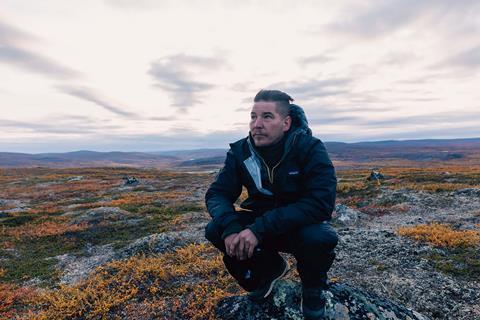Finnish filmmaker Jalmari Helander tells Screen about his action-packed, Nazi-fighting tale Sisu, which premieres in TIFF’s Midnight Madness.

I
t is no surprise that Sisu writer-director Jalmari Helander is wearing a t-shirt featuring Sylvester Stallone as Rambo when he speaks to Screen ahead of Toronto. “I’m a big fan of First Blood and all those kinds of movies in the ’80s and early ’90s,” says the Finnish filmmaker. “It was a dream of mine to make an action film in Finland, but it felt like a stupid dream for a long time. Now I was finally in the position that I was able to do it.”
Helander had already experienced success with his first two features, Rare Exports (2010) and Big Game (2014), which both screened at TIFF. Now he is playing in Midnight Madness with his third, an action-packed, bloody and darkly funny story of a tough Finnish ex-soldier escaping Nazi troops in 1945 in Finnish Lapland.
Helander sat down to focus on an action idea in 2020, feeling frustrated that it had been six years since Big Game and his next feature was on hold due to the pandemic (but will be resurrected soon). “Maybe you need to be in a bad place to do something cool,” he says. “I wrote it in about two months. It was just a simple idea that a guy finds gold and he has to fight the Nazis. I had so much fun in the writing process.”
To Helander’s surprise, when his producer started sending out the script, the responses he got were swift and positive. “When you have something simple, it can be quite easy to sell,” he says. His longtime producer Petri Jokiranta of Subzero led the team, which also brought on board the UK’s Mike Goodridge of Good Chaos as one of the executive producers. Nordisk Film has the Nordic rights and Sony/Stage 6 Films acquired world rights outside the Nordics.
The cowboy way

As much as films like First Blood influenced Helander, there are also inspirations from classic westerns by Sergio Leone and other directors. “I watched a lot of westerns with my dad when I was a child,” he says. “When I was editing the film, it fucked with my head because I realised everyone will say I’m trying to copy Tarantino. But it’s because Tarantino has mimicked all these movies so much that when someone else does it, they say he mimics Tarantino. So maybe that will happen anyway.”
Helander is upfront about his inspirations, noting that for the film’s typography “that was me copying The Bridge On The River Kwai”. But he also put a modern twist on the story. “The coolest job was trying to find inventive ways to kill Nazis,” he says. “Every day I was thinking, ‘What would be a weird way to kill someone that no-one else has done before?’ It was like a game.”
The ex-soldier, played by Jorma Tommila, does not speak for most of Sisu’s running time, but he does show his personality in other ways, finding increasingly inventive ways to extract himself from impossible situations. Having previously acted in Rare Exports and Big Game,
Tommila also happens to be Helander’s brother-in-law — although the director was a fan before his sister married the actor.
“I had no other actor in mind; something about his face is easy to watch even when he doesn’t talk,” says Helander. “He’s also really tough, especially for being 63.”
Helander’s past features have been set in northern Finland, but Rare Exports filmed in Norway while Big Game was shot in Germany. “Now I wanted to shoot in Lapland for real,” he says. “I wanted to go to the farthest end of Finland, to a place where you have no trees anymore. It was important to have these open, wide spaces, and this one man in these open spaces where he has nowhere to hide. The scenery in Lapland and the light was so great.”
Shooting over 35 days in the middle of 2021, Helander says the most challenging logistics were finding an old war plane (it was borrowed from a museum) and dealing with temperamental vintage cars and misbehaving horses. “The horses were just not following directions,” he says with a laugh. “Maybe it was the wind or something.”























No comments yet